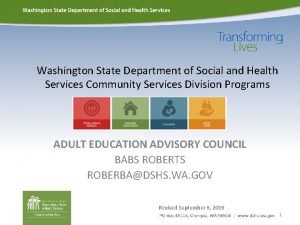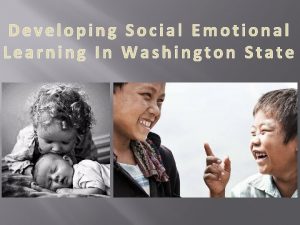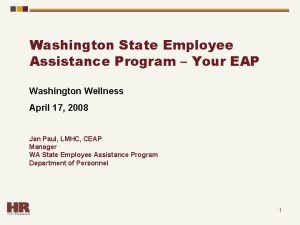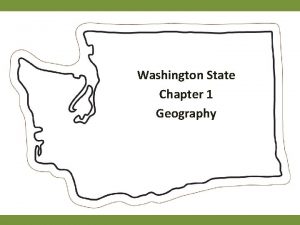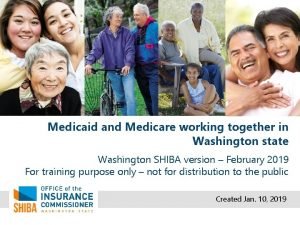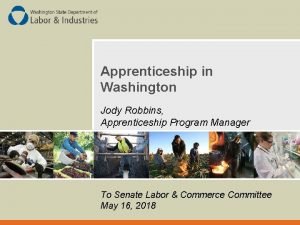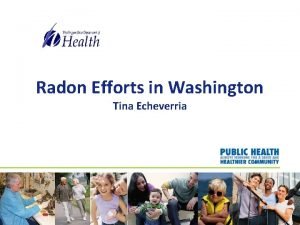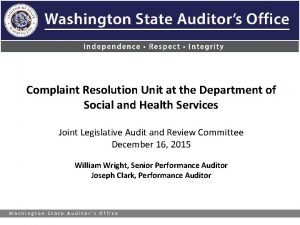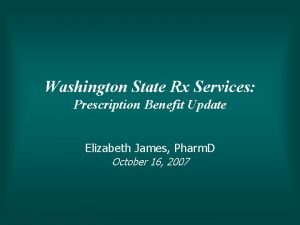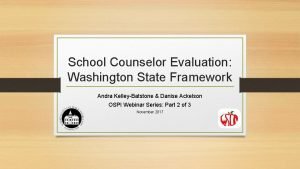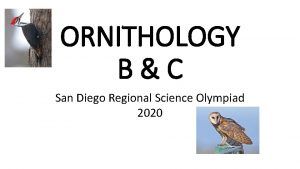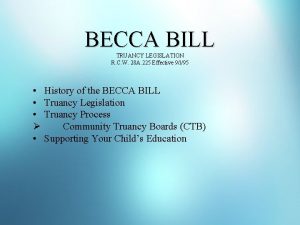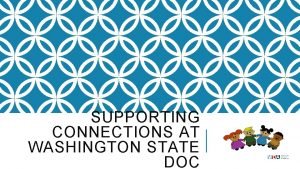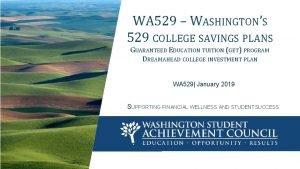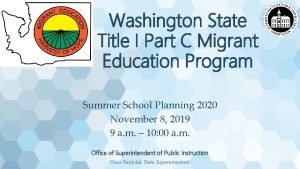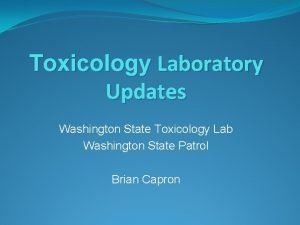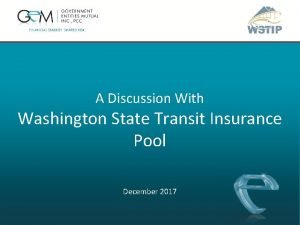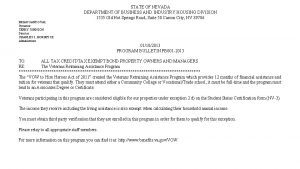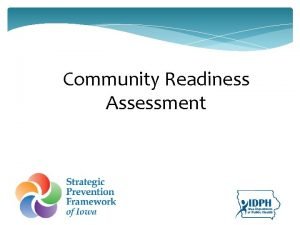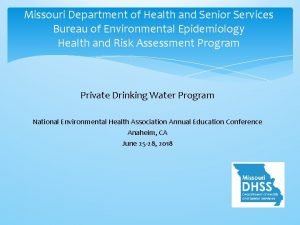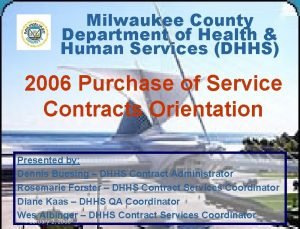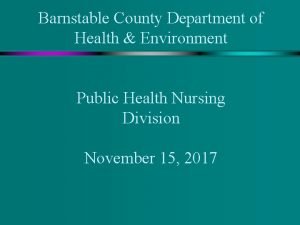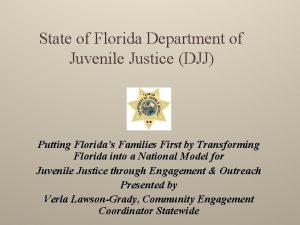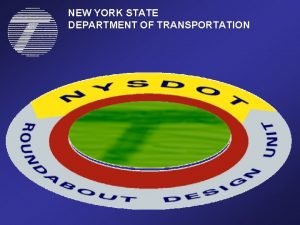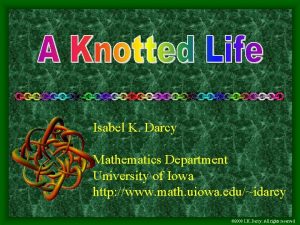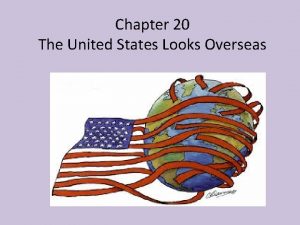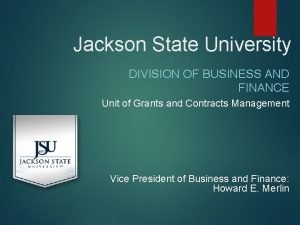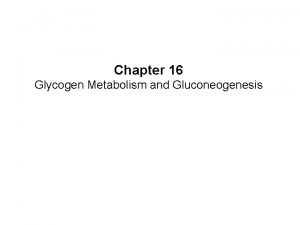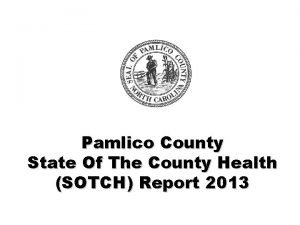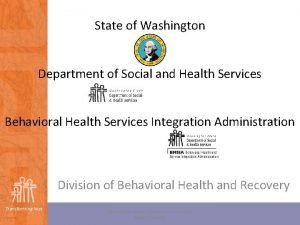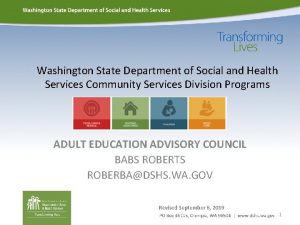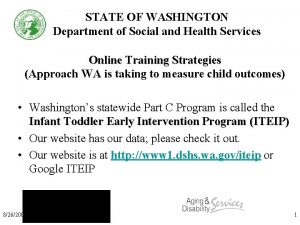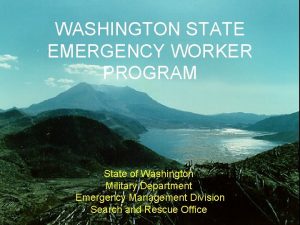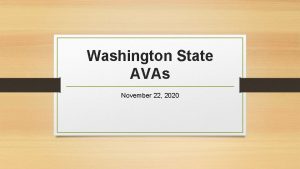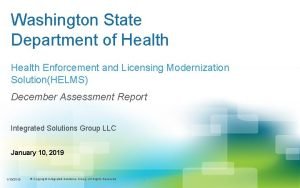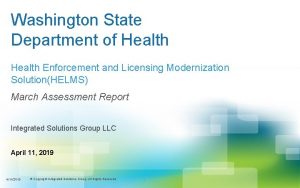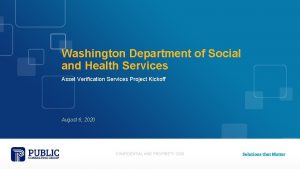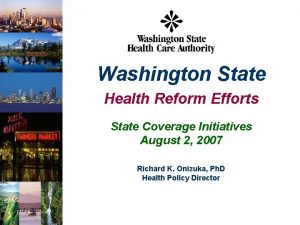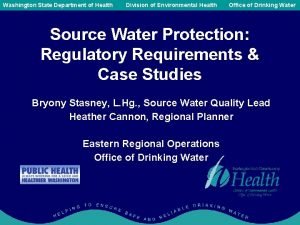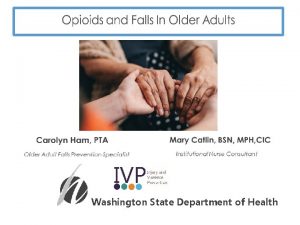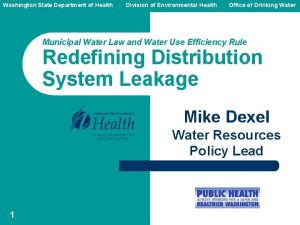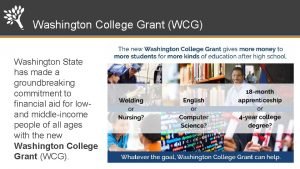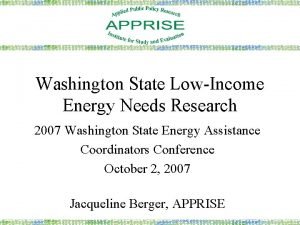STATE OF WASHINGTON Department of Social and Health



















































- Slides: 51

STATE OF WASHINGTON Department of Social and Health Services • Washington’s statewide Part C Program is called the Infant Toddler Early Intervention Program (ITEIP) • Our website is at http: //www 1. dshs. wa. gov/iteip or Google ITEIP • Our website has our data; please check it out. 8/28/2007 1

What Did States Learn from Child Outcomes Pilots and Field Tests? Overview of Session Provide key points as defined below: 1. Provide relevant information about how your state is organized/structured. 2. Describe the approach your state program is taking to measure child outcomes including the decision to use the COSF and the pilot/phase in process you are implementing. 3. Describe the resources and supports you utilized to implement the child outcomes process (could be your state staff, state or national TA providers, GSEG resources, etc. ) 4. Describe the first pilot/phase-in site(s) for collecting child outcomes measurement process. 5. What feedback was gathered? What was learned from the early implementation of the data collection? 6. What changes did you make as a result of the early feedback? e. g. Was there any change in requirements or guidance around the process? Was there any changes made to the form? Were any new materials or resources developed? 7. Next Steps for continuing to learn and improve the process (e. g. quality assurance) 8/28/2007 2

Child and Family Outcomes Child Outcomes: • Children have positive social-emotional skills (including social relationships) • Children acquire and use knowledge and skills (including early language/communication and {early literacy}) • Children use appropriate behaviors to meet their needs Family Outcomes: • Percent of parents/families participating in Part C who report that Early Intervention helped the family – know their rights – effectively communicate their children’s needs – help their children develop and learn 8/28/2007 3

What do you know about Washington? • Who is our state’s Governor? Christine Gregoire • Where is the State Capital? Olympia • Who is the State Part C Lead Agency? Department of Social and Health Services • How many Counties are in WA? 39 • How many islands does Washington State have? Go to Access Washington to find the number but the hint is “lots” • Where was this picture taken? 8/28/2007 4

There are 29 Federally Recognized Tribes 8/28/2007 5

Washington State Symbols • Arboretum: Washington Park Arboretum • Bird: Willow Goldfinch • Colors: Green and Gold • Dance: Square Dance • Fish: Steelhead Trout • Flower: Coast Rhododendron • Folk Song: " Roll On Columbia, Roll On" by Woodie Guthrie • Fossil: Columbian Mammoth of North America • Fruit: Apple • Gem: Petrified Wood • Grass: Bluebunch Wheatgrass 8/28/2007 • Marine Mammal: Orca • Insect: Common Green Darner Dragonfly • Motto: Alki, meaning "bye and bye“ • Nickname: The Evergreen State • Ship: "President Washington“ • Song: "Washington, My Home" by Helen Davis • Tartan: Background: green (rich forests); perpendicular bands: blue (lakes, rivers, and ocean), white (snow-capped mountains), red (apple and cherry crops), yellow (wheat and grain crops), black (eruption of Mt. St. Helens). • Tree: Western Hemlock 6

Washington State Population and Forecast Birth rates: Annual births are at 82, 000 now and should increase to about 100, 000 by 2016. By 2030 there are estimated to be 106, 000 births per year. State and local populations are greatly influenced by: Military impact (Army, Navy, Marines, Coast Guard, Air Force) in multiple counties throughout the state; the large number of families who move to WA each year for agricultural employment; and ongoing population shifting from place to place according to crop seasons, military assignment, and employment related to states largest industry (agriculture). Islands: Created on June 1, 1951, Washington State Ferries (WSF) is the largest ferry system in the United States and the largest ferry system in the world based on vehicles carried. More than 24 million people a year ride the ferries and over 30, 000 vehicles a day use this critical link in the state highway system. WSF has a fleet of 26 vessels and operates 20 terminals throughout Puget Sound. 8/28/2007 7

Washington State is a great place to work and play. We need early intervention staff - so come join us! Google: Access Washington and see: • http: //www. experiencewashington. com/v 5/Gui des. And. Maps/publications. aspx • The Official Site of Washington State Tourism Visitor Guides 8/28/2007 8

Washington Attractions: 8/28/2007 9

Washington State Historical Facts/Timelines • • 1579 Sir Francis Drake sailed up the Pacific Northwest Coast and named the entire region New Albion. 1775 Spain laid claim to the area. 1792 Many of our state landmarks named by Captain George Vancouver. Captain Robert Gray explored the lower reaches of the Columbia River. 1805 -06 Lewis and Clark expedition explored the Northwest and reached the Pacific Ocean at the mouth of the Columbia River. 1818 Fort Walla built by the North West Company. This enabled the United States to claim joint occupancy of the Oregon Territory with England. 1819 Spain gave the United States any and all rights claimed by Spain to the Oregon country. 1846 Oregon Territory became a part of the United States when the United States and Great Britain agreed to the 49 th parallel as the northern U. S. boundary. 8/28/2007 • • 1848 Oregon Territory was established with Washington as the northern part of the territory. 1853 Washington Territory, separate from Oregon, was created. Isaac Stevens was the first territorial Governor. 1863 Idaho Territory was created from part of the Washington Territory. 1889 Washington admitted to the United States on November 11 as the forty-second state. Elisha Ferry was the first elected Governor of Washington State. 1941 Grand Coulee Dam completed. 1980 Mount St. Helens erupted May 18. 1989 Washington celebrated 100 years of statehood on November 11. 10

Counties with Population Density Less Than 100 Persons per Square Mile As of April 1, 2007, the following counties had a population density of fewer than one hundred persons per square mile. Actual population densities in persons per square mile are shown in parentheses. 8/28/2007 • • • • Adams (9. 14) Grant (30. 77) Pend Oreille (9. 00) Asotin (33. 53) Grays Harbor (36. 93 San Juan (90. 90) Benton (95. 65) Jefferson (15. 76) Skagit (66. 45) Chelan (24. 37) Kittitas (16. 67) Skamania (6. 46) Clallam (39. 38) Klickitat (10. 63) Stevens (17. 35) Columbia (4. 72) • • • • Lewis (30. 78) Wahkiakum (15. 14) Cowlitz (85. 89) Lincoln (4. 46) Walla (45. 89) Douglas (19. 94) Mason (56. 81) Whatcom (88. 84) Ferry (3. 43) Okanogan (7. 55) Whitman (19. 77) Franklin (54. 25) Pacific (23. 15) Yakima (54. 51) Garfield (3. 31) 11

Many think of Washington related to our major population centers and cities Washington’s most populated counties are King, Pierce, Spokane, and Snohomish. Other counties with density areas above the last chart are Clark, Skagit, Kitsap and Island. Here a few examples of some of our largest cities: • • • 8/28/2007 Seattle Tacoma Everett Bellevue Spokane Yakima • • • Bellingham Kent Auburn Vancouver Wenatchee Tri Cities (Richland, Pasco, Kenniwick) 12

Much of Washington has many miles to travel to get to where children and families live, learn, and play. 8/28/2007 13

Infant Toddler Early Intervention Program (ITEIP) Structure (WA Early Intervention Services) (Logo courtesy of the Department of Social and Health Services Infant Toddler Early Intervention Program funded by the Individuals with Disabilities Education Act. ) ITEIP SICC (Part C) DSHS has the primary responsibility for implementation of IDEA, Part C (ITEIP). ITEIP administers this federally funded program, which serves children age birth to 3 with developmental delays and/or disabilities. The program is the payor of last resort and requires coordination and collaboration with five state agencies, appropriate DSHS divisions and programs, families, local service providers and agencies, interested Tribes, State Interagency Coordinating Council (SICC) members, and County Interagency Coordinating Councils (CICCs). DSHS DOH OSPI (Office of Superintendent of Public Instruction) (Department of Health) (Department of Early Learning) ITEIP SICC Member State Lead Agency SICC Member DEL (Department of Social and Health Services) SICC Member School Districts Provide early intervention services including Family Resources Coordinators (FRCs) facilitate identification of eligible infants, assist with eligibility determinations, participate in the development and implementation of the individual Family Service Plans, and coordinate services delivery activities and funding. (Educational Service Districts) Provide local funding and direct services. Federal BIA, HS, EHS, Tribes (Bureau of Indian Affairs, Head Start & Early Head Start) SICC Member Coordination of related community activities and transition planning for families with their children. Local Lead Agencies ESDs DSB (Services for the Blind) Nonprofit Agencies and Others Coordination and direct services. Provide direct service support for families of eligible children with blindness or vision impairments. Support and assist in service delivery options. SICC Member Children With Special Health Care Needs (CHSCN) ADSA ODHH (Deaf and Hard of Hearing) (Aging & Disability Services Administration Coordinates and develops specialized services for eligible infants and toddlers and their families. DDD (Division of Developmental Disabilities) DDD is the programmatic home for ITEIP: County Health Department Local Health District Provide Care Coordination thru Children With Special Health Care Needs 8/28/2007 ITEIP Web site -- http: //www 1. dshs. wa. gov/iteip/ (Provides DDD state-funded services and Supports). ADSA/ Information Technology ITEIP Data Management System CA Many services are provided to infants and their families through medical coupons. (Major Funder) DASA County Human Services Child Development Svcs. (Research and Data Analysis) (Health & Recovery Services Administration) Working to increase referral linkages in the CA for the purpose of implementing IDEA. (Drug and Alcohol) DDD Regions RDA HRSA (Children's Admin. ) Helps identify Infants with Fetal Alcohol Syndrome (FAS) and other conditions. FAS has been included as an ITEIP category of eligibility. Collaborate on treatment programs. MH (Mental Health) Coordinates to assure that mental health services are accessible and available to infants and toddlers and their families. Provides technical assistance in the collection and interpretation of data used to understand program delivery issues and develop service delivery options. Indian Policy and Support Economic Services Collaborates on efforts to facilitate early intervention services for Tribal infants' toddlers and families. Provides economic, employment and training, child support, medical, and other services to help people in need achieve and maintain their highest level of selfsufficiency. Work. First (TANF) (Temporary Assistance for Needy Families) Created by the ITEIP Data System Project Team Updated August 6, 2007 14

Summary of approach Washington is taking to measure child outcomes Washington implemented the Child and Family Outcomes Measurement Project as a multi-phased project to – Gather input from Washington Stakeholders concerning: • Method of the identification and measurement of child and family outcomes; • Determine how best to amend the ITEIP Data Management System; and, • Gear up to implement federal and related state requirements across Washington. 8/28/2007 15

Washington State Parameters for Child and Family Outcomes Measurement and Data Collection • Collection and reporting State Performance Plan data, including child and family outcomes is a federal requirement, not an option. • Reports must be aggregated data for state and local geographic areas and are to be reported to the U. S. Department of Education, Office of Special Education Programs, the Governor, and the public. • ITEIP worked with a stakeholder advisory group and the State Interagency Coordinating Council to determine the best approach. • Parents and families will be involved in child and family outcome measurement and skill summary discussions and collection. The ECO Center narrative terms are to be used to define the skills and progress for each child at entry into and exit from the Washington ITEIP and services. • Five sites piloted process and forms and their input was incorporated into Washington’s state implementation training held in May 2007. All training materials are on our ITEIP Website. 8/28/2007 16

WA State Parameters - Continued • Individualized Family Service Plan (IFSP) teams must complete and collect data for child outcomes. The National Early Childhood Outcome Center (ECO) Childhood Outcomes Center Summary Form (COSF) and process has been modified for Washington and will be used statewide. Teams are to include the professions licensed or credentialed who evaluate, assess, and explain results, the parent(s), and the FRC assigned to the family/child at the time of entry and time of exit. • The team discusses and works together for consensus on summaries of child’s skills and progress made. • Beginning July 1, 2007, entry child outcome summaries are being completed for each child entering ITEIP who were less then 2 years, six months old. 8/28/2007 17

WA State Parameters - Continued • Exit summaries must be completed for all infants and toddlers leaving ITEIP who have entry summaries AND who have been in early intervention services for six months or more. This occurs as soon as possible after July 1, 2007 for all infants and toddlers who have been in ITEIP for at least six months and who entered before the child was 2 and one half years old. • More than one evaluation and assessment tool is allowed for use at entry and exit times when measuring and collecting child outcomes data. All information available is part of the process. Functional skills and outcomes are to be discussed, incorporated, and recorded as part of the summary process. • Washington will not use any numbers when completing our summary process and forms. The forms have been modified to focus on language and not use numbers. We want no option or conversation for children to ever be referenced as, or related to, a number. 8/28/2007 18

WA State Parameters - Continued • Teams may choose to do outcome summaries and complete forms more often than at entry and exit. If so, they need to clearly document them as NOT the entry or exit form. • Because we are doing entry summaries upon the time of entry for all infants and toddlers, the infants who enter the system within the first few months of life may look very different in four to six months. Therefore we encourage the team to determine whether they should complete an additional summary for these children. • The Infant Toddler Early Intervention Program (ITEIP) Data Management System is being updated to collect, record, and generate aggregate state and local reports for child outcome data. Until the system is updated and ready, electronic or paper summary forms are being completed. Data will need to be entered into the data system prior to finalizing our Annual Performance Report. 8/28/2007 19

Family Outcome Measurement • Washington Family Outcomes will be measured by use of the National Early Childhood Outcome Center (ECO) survey tool and used statewide. This year, ITEIP has asked local lead agencies for assistance with distribution to complete the survey by Fall 2007. • As funding is available, we will be updating the ITEIP Data Management System to include the ECO survey, so it can be used to generate surveys and share with families at the time of the annual IFSP meetings and at the time of transitions by age three. These are times when interpreters are involved and available to assist non-English speaking and non reading parents and families complete the surveys. 8/28/2007 20

Family Outcome Measurement - Continued We are planning to align child identification numbers and family surveys in a confidential analysis of how we are doing for the families and how the child is doing as well. We want to review child and family outcomes to see if there are system issues identified. For example: • At Entry - To what extent does this child show age-appropriate functioning, across a variety of settings and situations, on each outcome? How does this relate to what the parents shared with us? • At Exit - Has the child shown any new skills or behaviors or not related to (each outcome) since the last outcome summary? How does this relate to what the parents shared with us at the time of transition? 8/28/2007 21

Resources and supports utilized to implement the child and family outcomes process This was a true national and state partnership. Our progress could not have been done without the partnership and support from WESTAT, SRI/ECO Center, NECTAC, state parents, SICC, stakeholders, and pilot sites. • During late 2005, WA state Infant and Toddler Early Intervention Program (ITEIP) partnered with WESTAT Inc. to submit a General Supervision Enhancement Grant (GSEG) proposal to the U. S. Department of Education, Office of Special Education Programs. • In March of 2006, WESTAT and ITEIP were notified of their selection to receive the grant. The purpose of the grant was to develop and pilot State Outcomes Indicators and Methods for Early Childhood Measurement. • The grant was used to assist the state in developing and implementing the Part C outcomes indicators, including methods to collect and analyze ITEIP state child outcome measures for infants and toddlers, birth to three, and their families. 8/28/2007 22

Resources and Supports - Continued In partnership, WESTAT and ITEIP, had four phases in the GSEG project: 1) obtain stakeholder input on the child and family outcomes; 2) send the recommendations to a broader group of stakeholders; 3) pilot collection of child and family outcome data; and, 4) plan and begin programming and updating the ITEIP Data Management System to collect and document the child outcome measures. • As part of this grant, we have obtained assistance from the nationally recognized staff of SRI International, Early Childhood Outcome Center. SRI has provided Kathy Hebbeler, a leading researcher in the field for outcomes and positive research results of early intervention and preschool services, to work with us. • We have also received support from NECTAC consultants: Lynn Kahn, Robin Rooney, and Christina Kasprzak. 8/28/2007 23

Specific Details of the Washington Child and Family Outcomes Measurement Project Phase 1 August 2006 through January 2007 – Stakeholder Workgroup Meetings 1. August 21, 2006, a statewide teleconference kick off call was conducted. DSHS Secretary Robin Arnold-Williams, SICC Chair Bonnie Sandahl, and Kathy Hebbeler were our key speakers and outlined state and national plans and details. 2. A total of 130 individuals from 68 sites in Washington State participated in this call. During the presentation participants learned about: o Purpose of the project and the role of the Workgroup in the activities. o Stakeholders represented a variety of interest groups such as parents, state and community organizations, schools, universities, and health plans. o All conference call participants were invited to apply to the Stakeholder Workgroup. 8/28/2007 24

Phase 1 - Continued 3. Early in September 2006: - Thirty Stakeholders were selected based on an application process and a variety of factors, including their geographic location, affiliation, availability to attend scheduled meetings, and complete assignments between them. Workgroup members included parents, providers, representatives from state agencies and a university. 4. WESTAT and ITEIP worked together to recruit and hire a State Outcomes Project Coordinator. The Coordinator was key in assisting with work group selection, preparing materials and agendas for workgroup meetings. 5. The charge of this Workgroup was to provide input on the measurement of child and family outcomes in Washington State and make recommendations on the process to be used. 6. Three Stakeholder Workgroup meetings were conducted: September 18, October 19, and November 20. Summaries from each meeting are available on the ITEIP Website. 7. In addition to meetings, four conference calls were conducted during this timeframe to address questions and obtain additional input from Workgroup members. 8/28/2007 25

Phase 2 January 2007 through February 2007 Stakeholder Feedback – Select Pilot Sites The following recommendations were identified by the Workgroup: 1. Enhance the Infant Toddler Early Intervention Program (ITEIP) Data Management System to facilitate analysis of child outcome data by selected variables. 2. Pilot the Child Outcomes Summary Form (COSF) developed by the Early Childhood Outcomes Center (ECO) to gather child outcomes data. 3. Select pilot sites using a range of criteria. 4. Use the Early Childhood Outcomes Center (ECO) Family Survey to gather family outcomes data. 5. Form a Pilot Site Steering Committee. 8/28/2007 26

Phase 3 December 2006 through April 2007 Set up and Conduct Pilot 1. Pilot site application announcements were sent via email to all ITEIP Stakeholders. 2. The application deadline was January 9, 2007. Five pilot sites were selected from a total of seven applicants to pilot the process of using the Child Outcomes Summary Form. We received no completed applications from Regions 4 or 6. . 3. Pilot sites were selected based on timely submitted application meeting designated criteria, and diverse locations throughout Washington State, and DSHS Regions. Pilots were located within the following DSHS regions and counties: Region 1: Chelan/Douglas Region 2: Yakima Region 3: Skagit Region 5: Kitsap and Pierce 8/28/2007 27

Phase 3 – Continued 4. On February 5 -6, 2007 pilot site team members, a total of 48 professionals, participated in a one and a half day training session that instructed them in how to use the process and form. Pilot Site Steering Committee and SICC members were also invited to participate in the pilot site training. 5. Following the training, weekly conference calls were conducted with pilot site key contacts and their teams to assess the implementation process and provide technical assistance on completed summary forms and to answer questions. 6. The Outcomes Project Coordinator (Jean Dauphinee) was key in providing ongoing assistance for pilot sites, coordinating state materials and activities and conducting weekly technical assistance calls for each pilot site. WESTAT staff, (Joy Markowitz), and ITEIP staff were also essential to the ongoing ITEIP outcomes measurement activity. Washington would not be where we are today without the hours of work by Jean and Joy from Westat, and the assistance from the SRI/NECTAC team. It took all their efforts, in addition to the ITEIP staff time and work, to really pull the entire project together and to implement statewide training. 8/28/2007 28

Phase 3 – Continued 7. Conference calls were also conducted on March 8 and April 12, 2007 for pilot site reporting to other pilot sites, Project Steering Committee and ITEIP/Westat, SRI and NECTAC. During the calls, teams shared their pilot experiences and outlined challenges. The Project Coordinator, ITEIP staff, and national consultants participated in these calls and continued to provide technical assistance to teams. 8. A total of 80 COSF processes were completed during the pilot period. At the conclusion of pilot site activities, a total of 150 professionals had participated in at least one COSF process with parents and families. Pilot teams trained an additional 77 professionals during their pilots and since the pilot site training. 9. Information gathered from pilot sites related to their implementation of the COSF process assisted in the identification of initial training needs and tools for Washington State. 8/28/2007 29

Phase 3 – Continued 10. The following tools were developed and/or customized for Washington State as a result of pilot site activities: – Child Outcomes Summary Form and definitions – Parent/family talking points – Team Decision Tree – Guidance on recording “Samples/Examples of Relevant Results” on the Child Outcome Summary Form – Brochure – Birth through Three Growth and Development Guide 8/28/2007 30

Phase 4 April 2007 through December 2007 Statewide Training and Data System Changes 1. 2. 3. 4. 5. Information gathered from pilot sites related to their implementation of the COSF, assisted in the identification of initial training needs within Washington State and the development of additional training materials provided at the statewide training and available on our website. May 22, 23, and 24, 2007 the Child and Family Outcome statewide training occurred, training approximately 400 additional individuals throughout Washington, using the tools and adapted Child Outcome Summary Form (COSF). Required COSF statewide collection began on July 1, 2007, using the paper process. Pilot site volunteers participated as mentors in the statewide training and shared their processes and experiences. Between October and December 2007, the ITEIP Data Management System upgrades will be completed. Providers and local lead agencies will be required to input data and information into the system. We will continue to look for funding and resources to maintain and update our data system. This is a challenge with the ongoing federal changes and timelines, so we will continue to work with OSEP to discuss and try to align the timing of data collection with the ability for states to update their process or systems and to complete the training needed to implement change statewide. 8/28/2007 31

What was learned from pilot sites and stakeholders early data collections? What changes did you make as a result of the early feedback? Statewide Training and Data System Changes • ITEIP and the Project Coordinator worked with WESTAT, SRI, and NECTAC staff to amend or create additional national and Washington materials for use in and out of the state. The materials were customized for our state. • On May 10, 2007 the Stakeholders Workgroup participated in a conference call to listen to pilot site reports and make final recommendations based on the findings. All the materials were developed and modified according to requests by the five pilot sites, ITEIP staff, National SRI, NECTAC, and WESTAT partners, and were finalized and prepared for the statewide training. • SRI and NECTAC staff: Kathy Hebbeler, Lynn Kahn, Robin Rooney, and Christina Kasprzak, and our Westat Project Coordinator, Jean Dauphinee, traveled with ITEIP staff to assist in three full days of training across the state (Seattle, Ellensburg, and Spokane). Trainers and local IFSP team members all traveled to spread the travel time out for all involved and minimize overall expenses. 8/28/2007 32

The following is a list of points raised during pilot site team conference calls. They were provided at statewide training to guide team's implementation of the Child Outcomes Summary Form (COSF) process: • Teams should use descriptive terms to discuss a child’s functioning and outcomes, rather than numeric ratings. Be sure that team and state staff practice positive skill language that does not reflect referring to a child as a number. • Reminder, there is no correction for prematurity in the Washington ITEIP. • Ensure that there are concrete examples of children's functional skills in the supporting evidence tables for each outcome. Standard scores and percentages are inclusive enough information for this purpose. Age ranges are relevant (e. g. , eating skills 12 -15 months). It might be helpful to consider change the column header from "Summary of Relevant Results" to "Samples or Examples of Functional Skills" 8/28/2007 33

Documents developed and/or modified for the state training: • The COSF Discussion Prompts document is designed to assist teams in asking questions during their discussions of child outcomes. It is a resource document that teams may refer to in preparing for and conducting discussions of children’s functional skills. One or two discussion prompts from each area may be used to inform families about the type of functional skills that will be discussed for the COSF. However, the entire list of questions is not designed as a checklist and should not be distributed to parents/families. • One pilot team identified the following web-based resource as particularly helpful in identifying examples of age appropriate behaviors and functional skills - http: //www. talaris. org/timeline_use. htm. • Additional resources were needed and developed. An informational brochure or talking points is in development by ITEIP and the National Consulting Team as a resource to support teams in discussing the measurement of child and family outcomes with parents and families. • Determining functional levels for very young infants is difficult. Teams have identified a need for additional resource information in this area. ITEIP and Project staff will continue to confer with ECO and NECTAC staff. 8/28/2007 34

ECO Form was modified and Washington process was aligned with National ECO Center’s process in requirements and guidance around the process as follows: • The statewide Washington training used the Child Outcomes Summary Form, modified to delete numbers, and was conducted May 22 -24, 2007. It was based on the input from the pilot sites, work between the Project Coordinator, ITEIP staff, WESTAT and the national SRI and NECTAC consultants. • Materials were jointly developed and customized for ITEIP/Washington use, as well as designed for general use for other states. SRI/ECO/NECTAC staff have worked to additional generic material to the National ECO Website, and to be used as appropriate when assisting other states. • The ITEIP Data Management System is being updated to facilitate collection and reporting of child and family outcomes. We expect this to be tested in October and to be competed no later then December 2007. 8/28/2007 35

Washington Infant Toddler Early Intervention Program Sandy Loerch Morris, Program Director Email: loercsk@dshs. wa. gov Phone: (360) 725 -3516 8/28/2007 36

Exhibit A CHILD OUTCOMES AND THE CHILD OUTCOMES SUMMARY FORM (COSF) PROCESS Frequently Asked Questions 1. What are the child and family outcomes? Child Outcomes: • Children have positive social-emotional skills (including social relationships) • Children acquire and use knowledge and skills (including early language/communication and {early literacy}) • Children use appropriate behaviors to meet their needs. Family Outcomes: • Percent of parents/families participating in Part C who report that Early Intervention helped the family - know their rights - effectively communicate their children’s needs - help their children develop and learn. • • • Additional Family Outcomes that will be measured using the Early Childhood Outcome Center Family Survey: Understand their child’s strengths, abilities and special needs Access desired services, programs, and activities in their communities For national information about the COSF and resources available on the Early Childhood Outcome Website, please visit: http: //www. fpg. unc. edu/~eco/. For additional Washington State information see the ITEIP Website: http: //www 1. dshs. wa. gov/iteip/ 8/28/2007 37

COSF Process Frequently Asked Questions - Continued 2. 3. 4. 5. 6. How is Washington going to measure parent/family outcomes? We will use the Early Childhood Outcomes Center Family Survey. National and state survey forms can be obtained from the respective web addresses listed previously. ITEIP plans to ask families to complete the survey at time of annual IFSPs and when they transition from the program. How are child outcomes being summarized in WA State? We will use the Early Childhood Outcomes Center Child Outcome Summary Form. Existing information about each child’s functioning and abilities will be aligned using the form to guide documentation of skills. Information recorded in the ITEIP Data Management System will be used in this process. Teams will work to reach agreement on skills and functions within the IFSP team process. When do I complete the COSF? At least upon entry into ITEIP, and when transitioning out of early intervention. Teams may decide to complete a new COSF process to document substantial changes in the child’s skills in addition to these required points in service, at any time. If so, they must be marked to document they are in addition to entry or exit summaries. How do I integrate the COSF process into the IFSP meeting? Based on input from pilot sites, teams felt it was easier to complete the COSF process at the beginning of IFSP meetings rather than the end. What if the child only exhibits delays in one outcome area? Functional skills in one outcome area may impact other outcome areas (i. e. articulation issues may influence functional behaviors across all three outcome areas. ) It is important to document skills in at least the three areas. 8/28/2007 38

COSF Process Frequently Asked Questions - Continued Concerning the COSF Process 1. What children should have child outcome measurements? 2. All children, eligible for ITEIP, entering and exiting the state program, except children who enroll at the age of 31 months or older, must have outcome summaries completed. There should only be one entry and one exit summary completed per child/family. Teams may use the summary form and process more often, but if doing so, should clearly document extra summaries to ensure state entry and exit summaries can accurately reflect aggregate reporting needs. 2. When and how long should a child be in ITEIP before his/her skills are measured? 3. Initial child outcome measures should occur upon family and child’s entry and be completed as part of the initial IFSP. Measurement summaries may occur throughout the time of the child and their family’s participation. However, any outcome measurement summaries completed between entry and exit will not be part of the aggregate data reported to OSEP for entry or exits. 4. Measurement must also occur as the child is exiting the state ITEIP and be conducted as part of the transition planning process. The child must be have been in service for at least six month before child outcome progress summaries can be collected. At this time, Washington will not include summaries of progress for children in the state program less than six months. 3. How do we handle children served by more than one early intervention program or service provider? 4. The FRC assigned at the time of entry into WA ITEIP, facilitates the team outcome measurement summary process and submits data into the data management system. This documentation may be printed for the child/family paper record. All IFSP team members, including parents/families, participate in the skill measurement discussion. Some teams may elect to only enter minimum summary information into the data management system, in which case they must maintain a comprehensive copy in the paper record. 8/28/2007 39

COSF Process Frequently Asked Questions - Continued Concerning the COSF Process – Continued 4. For children born prematurely, do we compare to a typical child of the same chronological age, or of the same corrected age? 5. Yes, compare to a typical child the same chronological age. Washington State ITEIP does not adjust age for children born prematurely. 5. If we know a child is exiting the local program before age three, should we complete another COSF process at the exit meeting? Does this depend on how recently the child’s development and skills were documented? Complete a COSF process at the last team meeting with the family, no matter when a previous summary was done, unless the child/family are exiting before being in the program for at least six months. Information is needed from all members of the IFSP team to determine exiting functional skill levels. Note: if in service less than six months, we will need to note the child was in the program less then six months so an exit summary was not completed. This should be recorded in Progress Notes of the ITEIP Data Management System. • Who is the “team”? The team consists of parents/family members, and professionals involved in evaluations, assessments, and providing services to the child/family. Professionals who are licensed to interpret and discuss evaluation and assessment data with parents/teams are critical members for discussions and reaching consensus of the child’s skills and developmental status. The Family Resources Coordinator, assigned to the family/child, both, at the time of entry and at the time of exit from the state program, should facilitate the team meeting and process. Families and children often move around so the summary/data will be maintained in the electronic system and also in paper files for reference as needed if teams are electing to only enter minimum summary details in the electronic system. 8/28/2007 40

COSF Process Frequently Asked Questions - Continued Definitions of Child Outcome Summaries 1. What are “foundational” and “immediate foundational skills”? An important developmental concept for understanding how to use the Child Outcomes Summary Form is the concept of foundational skills. Some of the skills and behaviors that develop early serve as the foundation for later skills and behavior. Or expressed another way, later skills build on earlier skills in predictable ways. Teachers, therapists, and parents can use the earlier skills to help children move to the next higher level of functioning developmentally. We refer to these earlier skills that serve as the base and are conceptually linked to the later skills, as “foundational skills. ” For example, children play along side one another before they interact in play. Development in the early childhood years proceeds through several levels of foundational skills with skills and behavior becoming more complex and more proficient as children get older. All skills that lead to higher levels of functional abilities are foundational skills, however, the set of skills and behavior that occur developmentally just prior to age-expected functioning can be described as the immediate foundational skills in that they are the most recent set of foundational skills that children master and move beyond. A child whose functioning is like that of a younger child is probably showing immediate foundational skills. Her functioning does not meet age expectations, but she demonstrates skills and behaviors that occur developmentally just prior to age expected functioning and are the basis on which to build age-expected functioning. A child whose functioning might be described as like that of a MUCH younger child does not meet age expectations, nor does she demonstrate skills and behaviors on which to build age-expected functioning. She has foundational skills, but not yet at an immediate foundational level. See also the document posted on the ITEIP Website titled: Age-Expected and Immediate Foundational Skills and the Child Outcome Summary Form Seven Point Skill Summary 8/28/2007 41

COSF Process Frequently Asked Questions - Continued Concerning the Child Outcome Summary Results 1. Can the form be modified? No, this is a form that must be used consistently statewide. The national form has been modified, for Washington, based on input from pilot sites and national consultants. One form is critical so that the state has consistent data for baselines and progress tracking. 2. Could there be different forms for different children – for children with developmental delays of various severity or children at risk, for example? No, we can not do this. The data recorded, using different forms, would not be consistent or allow aggregate information to be summarized. It is critical to have information collected that can be summarized in the same way for all child outcome measurements. 3. Why was the Child Outcome Summary Form designed and why did Washington decide on it to be the state’s process? There is no existing assessment based on the three child outcomes. The Child Outcomes Summary Form affords a method for providers to summarize information collected from multiple sources to address the three child outcomes. The COSF process is intended to facilitate state and local reporting and program improvement, as well as to meet federal reporting requirements. The COSF process is used to determine to what extent a child's functioning on each outcome is appropriate given his or her age, and whether that child made progress toward age appropriate behavior. Teams will determine individual child developmental status through discussion of the child’s functional skills and behaviors across a variety of settings and situations, and of child development expectations. ITEIP worked with a stakeholder workgroup and the State Interagency Coordinating Council (SICC) to determine this was really the only process available at this time to fully meet data requirements. 8/28/2007 42

COSF Process Frequently Asked Questions - Continued Concerning the Child Outcome Summary Results - Continued 4. What do I record on COSF forms in the ‘Persons involved in deciding the outcome skills summary’ section? Record all members of the team who were physically present during the IFSP meeting in which the child outcome summaries were discussed and determined. 5. What do I record on COSF forms in the ‘Samples/Examples of Relevant Results’ boxes? Record functional skills for the child that demonstrate individual abilities in each of the three outcome areas. Use of clear and positive statements and examples is necessary to summarize skills that demonstrate the child’s functional skills and level of development. Please reference the following document for examples of how to summarize samples/examples of relevant results: ITEIP Website link to the COSF Guidance document. 6. The box for samples/examples of relevant results (next to the “a” question) isn’t big enough to include all the child can do. The box allows the IFSP team to summarize progress the child is making, especially if the child is not “catching up” to typical functioning or is very atypical (e. g. in the “Emerging” or “Not Yet” categories in the “b” question. ) Detailed information on child progress should be written into the IFSP progress notes. There is no requirement to enter a lot of examples of progress. This should be brief statements or skill progress point’s describing progress. 7. What do I record in the ‘b’ boxes on the child outcomes measurement summary forms? 8. (If Question 2 a has been answered previously): Has the child shown any new skills or behaviors related to acquiring and using knowledge and skills since the last outcomes summary? (Select one) Yes � If Yes, Describe progress: No � 8/28/2007 43

COSF Process Frequently Asked Questions - Continued Concerning the Child Outcome Summary Results - Continued 8. Do I record information from the Family Statement on the COSF? To summarize skills and report progress, it is important to use all existing evaluation, assessment, observation, and parental and professional reports, or any information recorded in the ITEIP Data Management System. Parents are key informants and know how their child does when others are not around. Parent information must be included in this process. 8/28/2007 44

COSF Process Frequently Asked Questions - Continued Concerning the Team Process 1. What do I do if a member of the IFSP team does not attend the scheduled/confirmed IFSP meeting? The IFSP meeting must include, at least, the parent, FRC, and the qualified professionals from disciplines needed to interpret results of the evaluation, assessments, and other means of information documentation. The IFSP meeting must be scheduled to ensure appropriate attendance or participation in the team process. If qualified professionals are not available to be at the meeting, the meeting is not an IFSP meeting. 2. What should providers do if there is disagreement among team members as to what rating category to assign to a child on one of the outcomes? In order to minimize disagreements, we suggest teams start by talking about the functional outcome and the various ways, settings, and situations in which the child demonstrates skills and behaviors related to the outcome. The team should refer back to the progress notes, ongoing assessments, and observations, and add new information to the COSF and IFSP to describe the child’s progress toward each outcome. At the same time, it is recommended that team members who are most familiar with child development provide examples of skills or behaviors typical of a child the same age and those typical of a younger child. We also suggest providers ask parents whether they know other children the same age as their child (cousins, etc. ), without delays, and what they see those children doing in the outcome area. Focus on how the child is doing at the time. If one person feels a very different skill discussion is appropriate, the FRC/facilitator should ask that person to describe the child’s behaviors or skills and in what settings they are seen, which led them to their recommendation. The person who is facilitating the meeting should summarize what has been said and suggest the team work for consensus, reading the description of the skill summary category. 8/28/2007 45

COSF Process Frequently Asked Questions - Continued Concerning the Team Process – continued Write this evidence in the COSF, too. Then look at all the evidence together. Through this discussion, the team may come to a closer agreement. If the disagreement is only between two adjacent categories, the team may agree to average the ratings or choose one or the other. The team does need to reach agreement. In some cases the team may not reach total agreement. If team members disagree between adjacent categories, the team can choose any method they like to pick which one to check: for instance, “majority rules” or the team may agree to average the ratings. 3. Some children may never show typical behavior/skills. Due to their disability, disease or condition, their behavior will remain far below typical or even regress. How can the team approach the Child Outcome Summary Process without upsetting the parent? If the team has just finished reviewing the assessment results and writing the samples/examples of relevant results, the parent is already thinking about their child’s level of development. Be sure the parent/family is part of the information sharing. Ask the parent to share positive skills they see even if not where his cousin, neighbor, or friend is at. Assist in recognizing and documenting all progress. 8/28/2007 46

COSF Process Frequently Asked Questions - Continued Concerning the Team Process – continued 4. Do we have to complete an entire Child Outcomes Summary Form process for children who are only eligible for speech or language services? Yes, summary information is needed for each of the three child outcomes. Functional skills in one outcome area may overlap with skills and outcomes in other outcome areas (i. e. articulation issues may influence functional behaviors across all three outcome areas. ) 5. What do I do if there is only a single contracted service provider who serves the child/family and no one else at my location has recently interacted with the child/family? Comprehensive evaluations and assessments are required to be part of the IFSP process, whether doing outcome summaries or not. When resources are not available in the area, FRCs and Local Lead Agencies must have methods to bring in team members from other areas to participate in the process until local resources can be recruited. Obtain the information from all professionals and family members who have knowledge of the child’s functioning across situations and settings. 8/28/2007 47

COSF Process Frequently Asked Questions - Continued Concerning Relationship of Child Outcomes to Other Assessments 1. How is the COSF summary process different from standardized assessment results (e. g. BDI, HELP, AEPS, etc. )? The purpose differs. Assessments document child development in the five developmental domains in detail, so IFSPs can be developed. Child outcome summary discussions should enhance assessment information. This process compares child’s behavior and skills in the three functional outcomes across multiple situations and settings, to a typical child. Other standardized assessments compare a sample of the child’s behavior and skills in each of the five domains to typical development. 2. Should I record results of ongoing assessments on the COSF? Yes. Use current assessment results for the time the summary is being done. Ensure that there are concrete examples of children's functional skills, at the time of the meeting, in the supporting evidence tables for each outcome. Standard scores and percentages are not relevant information for this outcomes measurement summary purpose, as they do not state skills in functional terms. Age ranges are relevant (e. g. , eating skills 12 -15 months with examples of skills). 3. For a child exiting early intervention and moving into 619 preschool, can the exit COSF be used as an intake measurement for 619? The Office of the Superintendent of Public Instruction (OSPI) 619 preschool program is using the ECO Child Outcomes Summary process as well. There is a slightly different process however, and timelines many differ as well. IFSP and IEP teams must work together to coordinate ITEIP exit data with three to five preschool special education entry processes. We hope to see collaborative strategies on how to do the entry and exit process as comprehensively as possible, while minimizing the need for multiple meetings and avoiding duplication of discussions for parents, families and team members. 8/28/2007 48

COSF Process Frequently Asked Questions - Continued Concerning Relationship to IFSP 1. Will every child be required to have an IFSP outcome related to one or more of the three outcome measurement areas? No. IFSP outcomes and criteria should still reflect the IFSP team members’ priorities of what is most important for the family and child, and what the next steps are in addressing those important areas. IFSP teams will want to consider the three outcomes while discussing and prioritizing what functional skills and behaviors are important to achieve within the next year. 2. At what point in the IFSP meeting will the outcome summary occur? Pilot teams felt completing the COSF process at the beginning of IFSP meetings was most effective. The discussions should be integrated into team meetings and be completed prior to finalizing the IFSP and prior to the child leaving the state ITEIP. Concerning Staff Overload 1. Can we use a single, ongoing assessment to report outcome data? Currently, no single standardized assessment directly addresses the three functional outcome areas and compares the child to a typically developing child in those areas. OSEP requires us to report data on child progress in the three outcomes. The Early Childhood Outcome Center (ECO) was contracted with by OSEP to provide a method to document child and family outcomes. The Child Outcomes Summary Form (COSF) and process provides a method to summarize all available information about a child’s functioning (e. g. evaluations, assessments, and observations) for roll up discussion and documentation on the forms. 8/28/2007 49

COSF Process Frequently Asked Questions - Continued Concerning Interpretation of the Child Outcome Data 1. How will outcome data for children and families be used? Summary results of child and family outcome data will be used to: § Improve local services and programs for children and families in Washington State. Summary reports can be used on an ongoing basis to review outcome data. § Provide the state with aggregate results to inform policy and technical assistance. Local and state summary data is required to be reported to the federal government, state agency, Governor, and the public in aggregate reports and on an annual basis. § Inform federal and state policy and decision-making after several years of data collection. 2. Will state/OSEP be looking at length of time the child is served to explain benefit or lack of benefit? How will the measurement system include how much the child/family actually participated in services? OSEP has not requested any data on length of enrollment or participation in services. In ITEIP, we are collecting the date of each measurement. The range from first to last date of measurement will approximate the duration of enrollment. All children entering will have their skills summarized in the three areas. Children in service six months or more will have an exit summary, which include progress data as well. 3. If OSEP sees poor child outcomes, will they then take away dollars from programs when the problem may be bigger than a program can effect (e. g. a systems problem, a societal problem, etc. )? It is not yet known how OSEP will use the aggregate outcomes data. We are discussing how to report the data to help policy makers understand the complexity which underlies benefits achieved. It will be critical to carefully analyze data and include details relating to data that will aid individuals reading reports to have information that helps explains aggregate summaries and data. 8/28/2007 50

COSF Process Frequently Asked Questions - Continued Concerning Interpretation of the Child Outcome Data - Continued 4. Will OSEP understand the kinds of intense, complex needs families have? Qualitative descriptions will enhance understanding of the summary data and define the population of infants, toddlers, and their families served throughout the state and country for all of us. Concerning Data Submission 1. Where will outcome summary data go? ITEIP is modifying the existing data management system so information from the Child Outcomes Summary Form (COSF) can be entered into the enhanced Washington ITEIP Data Management System. Data will be entered at the local service level, and transmitted electronically to the ITEIP/DSHS. Data will be combined into a report for OSEP through the system for state and local aggregate data reporting. 2. Who enters the COSF information into the Data Management System? ITEIP prefers this to be the FRC. However, some local agencies assign entering information to another individual. Therefore, it should be the same individual who enters the IFSP into the system. Concerning Implementation in Washington 1. What are the timelines? Statewide Training for implementation of Child and Family Outcomes Measurement Process: May 22 -24, 2007 – COSF training will be provided communities around the state via three central locations. The implementation of the measurement process and reporting must begin by July 1, 2007 to ensure Washington has beginning baseline information to report by February 2008. Collection of all entry and exit summaries begins with paper versions of the COSF and should be maintained in children’s files following the statewide training. Required electronic submission of COSF process will be in place when the ITEIP data management upgrades are projected to be implemented, by October 2007. 8/28/2007 51
 Washington state department of social and health services
Washington state department of social and health services Washington state social emotional learning standards
Washington state social emotional learning standards West calcasieu cameron 3767 baton rouge la 70821
West calcasieu cameron 3767 baton rouge la 70821 Health and social care component 3
Health and social care component 3 Washington state board for community and technical colleges
Washington state board for community and technical colleges Washington state eap
Washington state eap Washington state geography
Washington state geography Shiba rainbow chart
Shiba rainbow chart Washington rn licensure
Washington rn licensure Biomes in washington
Biomes in washington Washington state apprenticeship programs
Washington state apprenticeship programs Washington state dairy council
Washington state dairy council Wheres washington state
Wheres washington state Washington state radon map
Washington state radon map Complaint resolution unit
Complaint resolution unit Washington rx services
Washington rx services School counselor certification washington state
School counselor certification washington state Scioly ornithology
Scioly ornithology The becca bill
The becca bill Washington state women's prison
Washington state women's prison Geography washington state
Geography washington state Wa529
Wa529 Washington dc state
Washington dc state Nursing quality assurance commission
Nursing quality assurance commission Washington state migrant council
Washington state migrant council Washington state patrol toxicology lab
Washington state patrol toxicology lab Washington state transit insurance pool
Washington state transit insurance pool Nevada department of business and industry
Nevada department of business and industry Nevada department of business and industry
Nevada department of business and industry State of nevada department of business and industry
State of nevada department of business and industry Social thinking and social influence in psychology
Social thinking and social influence in psychology Social thinking social influence social relations
Social thinking social influence social relations Iowa department of health and human services
Iowa department of health and human services Department of health and senior services missouri
Department of health and senior services missouri Milwaukee county health and human services
Milwaukee county health and human services Maine department of health and human services
Maine department of health and human services Barnstable county department of health and environment
Barnstable county department of health and environment State of florida department of juvenile justice
State of florida department of juvenile justice State of alabama department of finance
State of alabama department of finance Texas state university psychology
Texas state university psychology How many roundabouts in new york
How many roundabouts in new york University of iowa math department
University of iowa math department The state department us for
The state department us for Oklahoma state department of education math standards
Oklahoma state department of education math standards Penn state atmospheric science
Penn state atmospheric science Jackson state university finance department
Jackson state university finance department Michigan state physics
Michigan state physics Good state graphs and bad state graphs in software testing
Good state graphs and bad state graphs in software testing Absorptive state and postabsorptive state
Absorptive state and postabsorptive state Production of glycogen
Production of glycogen State graphs in software testing
State graphs in software testing Pamlico county health department
Pamlico county health department
